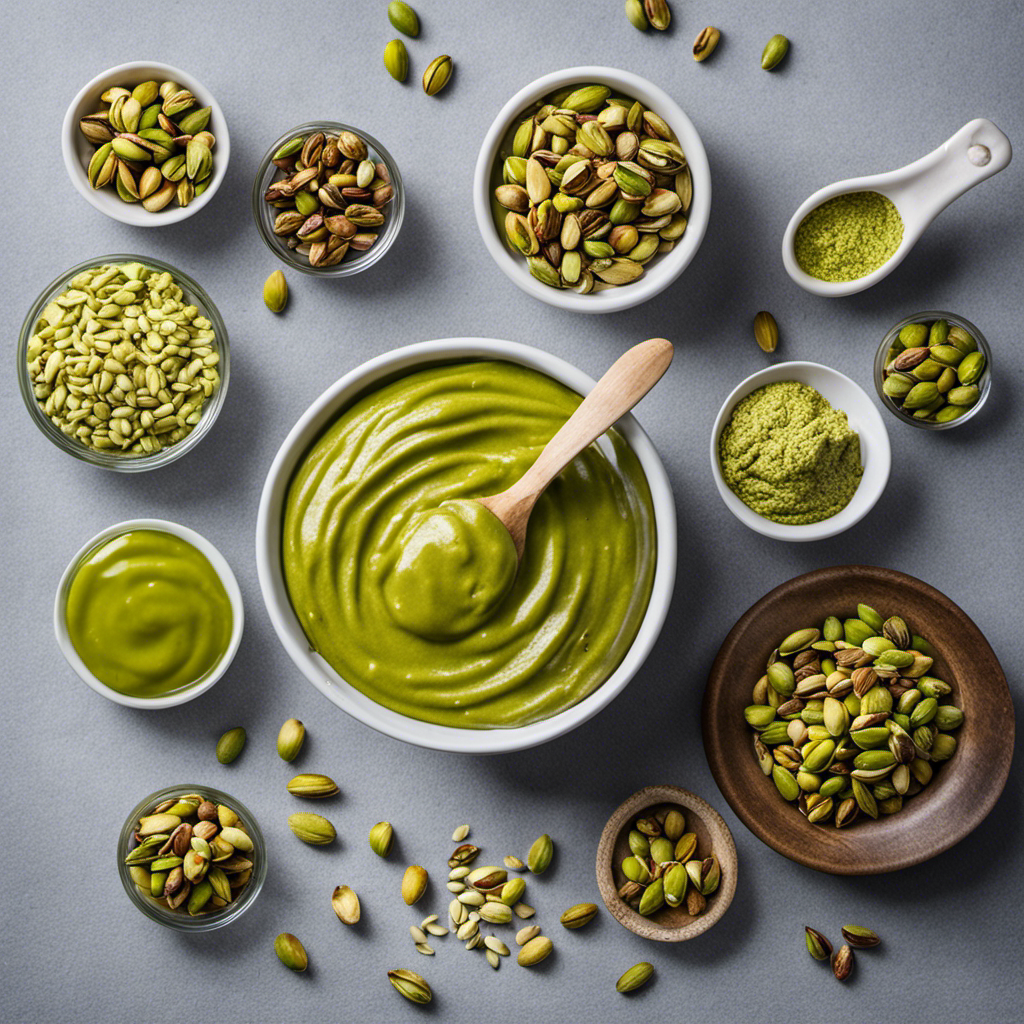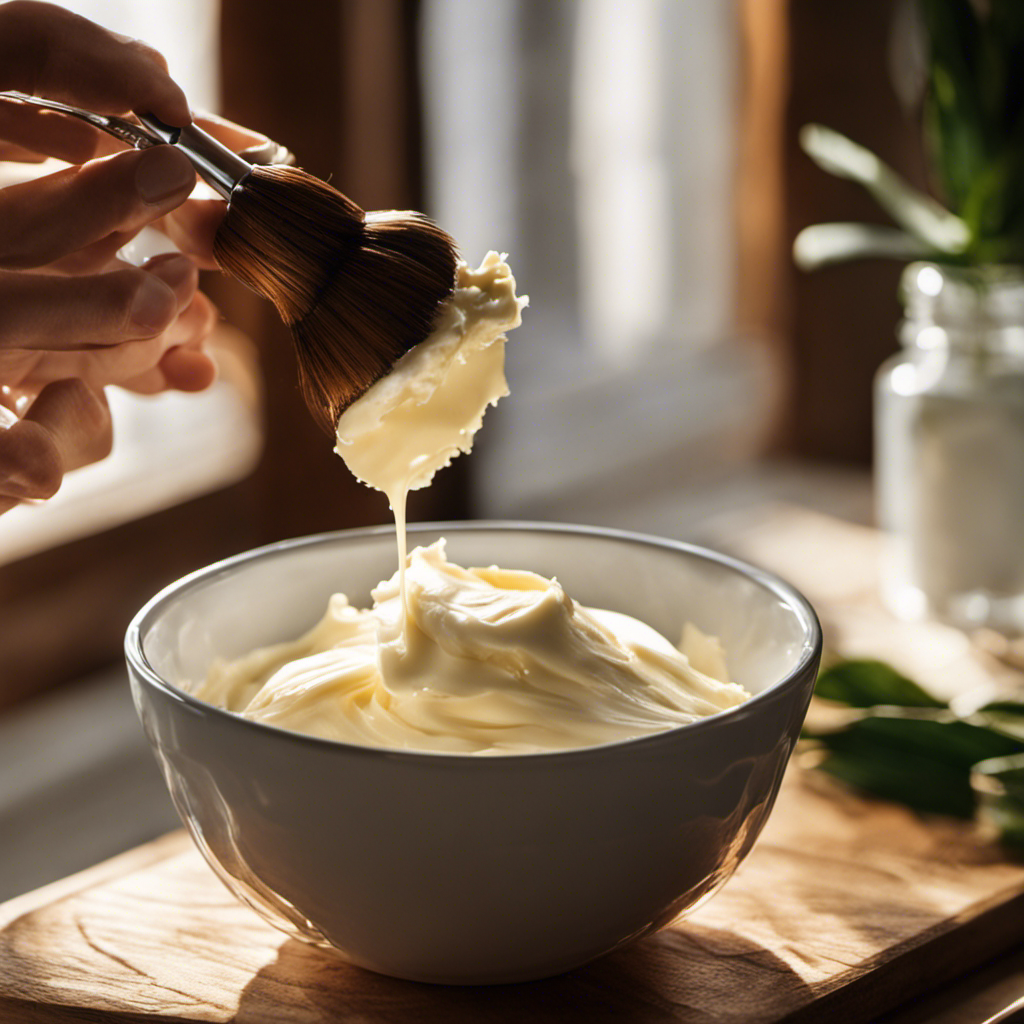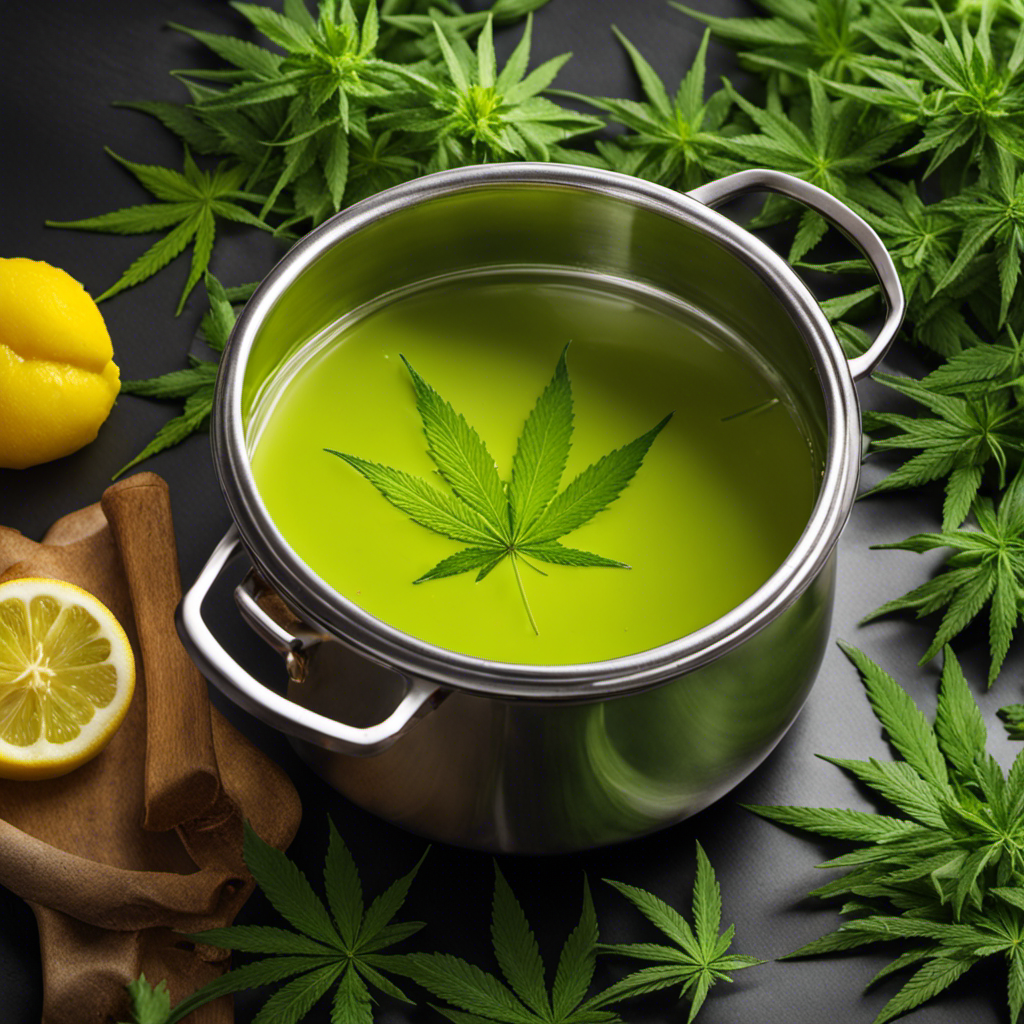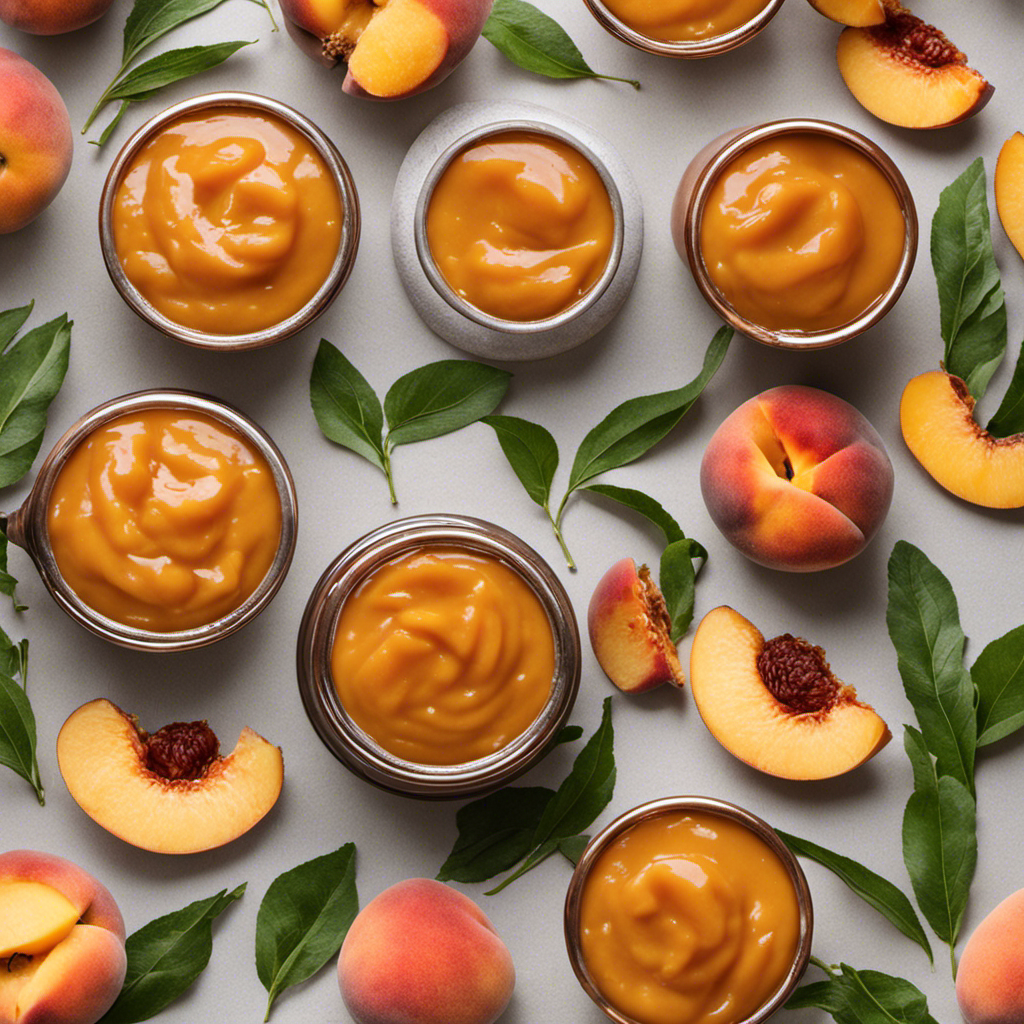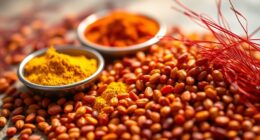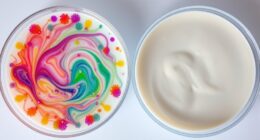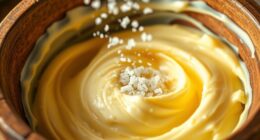As someone who adores pistachios, I’m constantly searching for fresh and innovative ways to savor these delectable nuts. That’s why I’m excited to reveal my reliable technique for crafting rich, irresistible pistachio butter.
In just a few simple steps, you’ll be able to create a spread that is not only packed with flavor but also loaded with health benefits. So grab your apron and let’s dive into the world of homemade pistachio butter together.
Trust me, it’s worth every nutty effort!
Key Takeaways
- Pistachio butter is a nutritious spread packed with essential nutrients like healthy fats, protein, and fiber.
- Incorporating pistachio butter into your diet provides numerous health benefits due to its high content of vitamins and minerals.
- The choice between roasted and raw pistachios will determine the flavor and texture of the butter.
- Consider whether to use salted or unsalted nuts based on personal preference and dietary needs.
The Health Benefits of Pistachio Butter
Pistachio butter is a delicious and nutritious spread that can provide various health benefits. Made from roasted and ground pistachios, this creamy and nutty butter is packed with essential nutrients.
It is a great source of healthy fats, protein, and fiber, making it a satisfying and filling snack. Pistachio butter also contains important vitamins and minerals, such as vitamin E, potassium, and magnesium, which contribute to overall health and well-being.
The rich and distinctive flavor of pistachios adds a unique twist to any dish. It pairs well with fruits like apples and pears, or can be spread on toast, added to smoothies, or used as a dip for vegetables.
Incorporating pistachio butter into your diet not only adds a delicious element to your meals, but it also provides numerous health benefits.
Choosing the Right Pistachios for Your Butter
When it comes to making pistachio butter, the choice between roasted or raw pistachios and salted or unsalted nuts can have a significant impact on the final outcome.
Roasted pistachios add a deep, nutty flavor to the butter, while raw pistachios result in a more mild and subtly sweet taste.
Similarly, salted nuts bring a savory and slightly tangy element to the butter, while unsalted nuts allow the natural flavors of the pistachios to shine through.
Roasted or Raw Pistachios
To enhance the flavor of your pistachio butter, you can choose between using roasted or raw pistachios. Both options have their own unique characteristics that can elevate the taste of your homemade butter.
Here are three factors to consider when deciding between roasted and raw pistachios:
-
Flavor: Roasted pistachios have a deep, nutty flavor with a hint of smokiness. The roasting process intensifies the natural sweetness of the nuts, resulting in a rich and robust taste. On the other hand, raw pistachios have a milder flavor, allowing the natural nuttiness to shine through without any added complexities.
-
Texture: Roasted pistachios have a slightly crunchier texture compared to raw ones. The roasting process adds a pleasant crispness, which can provide a delightful contrast when blended into a creamy butter. Raw pistachios, on the other hand, have a softer and more tender texture, resulting in a smoother and silkier butter.
-
Color: Roasted pistachios have a darker hue, ranging from golden brown to deep amber. This darker color can lend a beautiful caramel tone to your pistachio butter, making it visually appealing and appetizing. Raw pistachios, on the other hand, have a lighter shade of green, which can give your butter a vibrant and fresh appearance.
Whether you choose roasted or raw pistachios, the process of making pistachio butter remains the same. Start by grinding the nuts in a food processor until they transform into a smooth and creamy consistency. Add a pinch of salt and a drizzle of honey or maple syrup for added sweetness, if desired. Blend everything together until well combined, and voila! You have a delectable pistachio butter that can be enjoyed on toast, in baked goods, or simply eaten by the spoonful.
Experiment with both roasted and raw pistachios to find your preferred flavor profile. Whether you crave the boldness of roasted pistachios or the simplicity of raw ones, pistachio butter is sure to be a delicious and versatile addition to your pantry. So go ahead, indulge in the lusciousness of homemade pistachio butter and savor the nutty goodness it brings to your culinary creations.
Salted or Unsalted Nuts?
If you prefer a bolder flavor, opt for salted nuts when making your homemade pistachio butter. The choice between salted and unsalted nuts can greatly impact the taste of your final product.
Salted nuts add a savory and slightly salty kick to the creamy pistachio butter, enhancing its overall flavor profile. However, it’s important to note that salted nuts can also increase the sodium content in your pistachio butter. If you’re watching your sodium intake, it’s best to go for unsalted nuts. They still provide the rich and nutty taste without the added salt.
Regardless of your choice, making pistachio butter at home is a simple and rewarding process. Just blend roasted pistachios with a touch of salt, if desired, until smooth and creamy. Enjoy the deliciousness spread on toast, drizzled over desserts, or simply eaten by the spoonful.
Roasting Pistachios: A Step-by-Step Guide
After roasting the pistachios, let them cool before proceeding to the next step. Roasting pistachios brings out their natural nutty flavor and enhances their crunchiness.
Here are three different roasting methods to try:
-
Oven Roasting: Preheat the oven to 350°F (175°C). Spread the pistachios in a single layer on a baking sheet and roast for about 10-12 minutes, or until they are lightly golden and fragrant.
-
Stovetop Roasting: Heat a dry skillet over medium heat. Add the pistachios and stir constantly for 5-7 minutes, until they are toasted and aromatic.
-
Microwave Roasting: Place the pistachios in a microwave-safe bowl and microwave on high for 1 minute intervals, stirring after each interval, until they are crisp and golden.
The optimal roasting time may vary depending on the size and freshness of the pistachios, so keep a close eye on them to prevent burning.
The roasted pistachios will have a delightful aroma and a satisfying crunch, making them perfect for making homemade pistachio butter.
Grinding Pistachios to Perfection
When it comes to making the perfect pistachio butter, achieving a smooth consistency is key.
To achieve this, it’s important to use optimal grinding techniques. By using a high-powered food processor or blender, you can ensure that the pistachios are ground to a fine and creamy texture, resulting in a butter that is velvety and spreadable.
Optimal Grinding Techniques
To achieve optimal grinding techniques for your pistachio butter, start by using a food processor or blender. Here are three key tips to ensure the best results:
-
Grinding Speed: Set your food processor or blender to a medium-high speed to break down the pistachios efficiently. Too low of a speed may result in a grainy texture, while too high of a speed can overheat the pistachios and affect the flavor.
-
Nut Butter Consistency: Check the consistency frequently during the grinding process. Stop and scrape down the sides of the bowl to ensure even grinding. If the pistachios are not breaking down smoothly, add a small amount of oil (such as neutral-tasting vegetable oil) to help achieve a creamy texture.
-
Patience is Key: Grinding pistachios into butter takes time. Be patient and allow the machine to do its work. It may take several minutes of continuous blending to achieve the desired smoothness.
By following these techniques, you’ll be well on your way to achieving a creamy and delicious pistachio butter.
Now, let’s move on to the next step: achieving a smooth consistency.
Achieving Smooth Consistency
To achieve a smooth consistency, you’ll want to ensure that you are regularly pausing to scrape down the sides of the bowl during the grinding process. This step is crucial for optimal blending techniques when making pistachio butter.
As a food writer and recipe developer, I’ve encountered my fair share of consistency issues, but I’ve learned some useful tips along the way.
First, make sure your pistachios are roasted and cooled before grinding. This will enhance their flavor and ensure a smoother texture.
Second, be patient. Grinding pistachios into butter takes time, so don’t rush the process.
Lastly, if you find that your pistachio butter is too thick or grainy, try adding a little bit of oil, such as almond or coconut oil, to help achieve a creamier consistency.
Adding Flavor Variations to Your Pistachio Butter
For added variety, you can mix in different flavors to your pistachio butter. Here are three unique combinations to enhance the taste of your homemade spread:
-
Chocolate Pistachio Butter: Add a few tablespoons of cocoa powder to your pistachio butter for a rich and decadent twist. The combination of creamy pistachios with the deep, bittersweet flavor of chocolate is simply irresistible.
-
Honey Roasted Pistachio Butter: Roast your pistachios in the oven until they are golden and fragrant. Then, blend them with a drizzle of honey to create a sweet and nutty spread. The hint of caramelization from the roasting process adds a delightful depth of flavor.
-
Spiced Pistachio Butter: Sprinkle in a pinch of cinnamon, nutmeg, and cardamom to give your pistachio butter a warm and aromatic touch. These spices complement the natural nuttiness of pistachios and create a delightful balance of flavors.
Experimenting with different flavor pairings is a fantastic way to elevate your pistachio butter and create a unique and personalized spread. Get creative and let your taste buds guide you!
Sweet Vs. Savory Pistachio Butter Recipes
When it comes to pistachio butter, there’s a debate between sweet and savory flavor preferences. Some people love the rich sweetness of adding honey or maple syrup to their pistachio butter, while others prefer the savory notes of garlic, herbs, and spices.
In this discussion, we’ll explore the different recipe variations for sweet and savory pistachio butter, providing detailed instructions and mouthwatering descriptions to help you decide which one to try first.
Flavor Preferences: Sweet? Savory
Are you more of a fan of sweet or savory flavors for your pistachio butter?
When it comes to pistachio butter, there are endless possibilities for experimenting with different flavor combinations. Here are three reasons why you should explore both the sweet and savory flavor profiles:
-
Sweetness adds a delightful twist to the rich and nutty taste of pistachio butter. Imagine the creamy texture of pistachio butter combined with the sweetness of honey or maple syrup. It’s a match made in heaven!
-
On the other hand, savory flavors can bring a whole new dimension to your pistachio butter. Picture the earthy and aromatic notes of roasted garlic or herbs like rosemary and thyme. These savory additions can take your pistachio butter to a whole new level of deliciousness.
-
By experimenting with different flavor combinations, you can cater to different taste preferences and create a variety of options for your pistachio butter lovers.
Now that we’ve explored the sweet and savory flavors, let’s dive into some recipe variations: sweet or savory?
Recipe Variations: Sweet or Savory?
If you’re feeling adventurous, you can try adding a touch of sweetness or opting for a savory twist in your pistachio butter recipes.
Pistachio butter is a versatile ingredient that can be used in a variety of dishes, both sweet and savory.
For those with a sweet tooth, there are endless possibilities. You can use the pistachio butter to make delicious desserts like pistachio butter cookies, pistachio butter brownies, or even pistachio butter fudge. The creamy, nutty flavor of the pistachios pairs perfectly with the sweetness of these treats.
On the other hand, if you prefer a savory option, you can use the pistachio butter as a base for a delicious dip. Mix it with some herbs and spices, like garlic and lemon zest, to create a flavorful pistachio dip that pairs perfectly with fresh vegetables or crackers.
The options are endless when it comes to pistachio butter, so don’t be afraid to get creative in the kitchen!
Storing and Preserving Homemade Pistachio Butter
To keep your homemade pistachio butter fresh and flavorful, store it in an airtight container in the refrigerator.
Here are three important things to know about storing and preserving your pistachio butter:
-
Shelf life: Homemade pistachio butter can typically be stored in the refrigerator for up to two weeks. However, it’s best to check for any signs of spoilage, such as an off smell or mold, before consuming.
-
Airtight container: Using an airtight container is crucial to prevent oxidation and maintain the quality of the pistachio butter. This will help to preserve its creamy texture and rich flavor.
-
Avoid moisture: It’s important to keep your pistachio butter away from moisture, as it can cause the butter to become rancid or develop mold. Make sure the container is tightly sealed and stored in a dry area of the refrigerator.
By following these storing methods, you can enjoy your homemade pistachio butter for longer and savor its delicious taste.
Now, let’s explore some creative ways to use pistachio butter in your recipes.
Creative Ways to Use Pistachio Butter in Your Recipes
One great way to incorporate pistachio butter into your recipes is by spreading it on toast or bagels for a delicious and nutritious breakfast option.
The creamy texture and rich flavor of pistachio butter make it a perfect substitute for traditional spreads like peanut butter or cream cheese.
It adds a unique twist to your morning routine, giving you a burst of nutty goodness that will leave you craving more.
But don’t stop there! Pistachio butter can be used in a variety of desserts as well.
From cookies to cakes, it adds a delightful nuttiness that pairs perfectly with sweet treats.
Imagine biting into a soft, chewy cookie with a hint of salty pistachio flavor.
Or indulging in a velvety pistachio buttercream frosting on top of a moist chocolate cake.
The possibilities are endless when it comes to using this versatile ingredient in your culinary creations.
So go ahead, get creative and explore the world of pistachio butter desserts.
Your taste buds will thank you.
Pistachio Butter as a Nutritional Substitute
Incorporating pistachio butter into your recipes is a great way to enjoy a nutritious and flavorful alternative to traditional spreads. Not only does pistachio butter add a rich and creamy texture to dishes, but it also provides a host of health benefits. Here’s why you should consider incorporating pistachio butter into your daily meals:
-
Nutritional Powerhouse: Pistachio butter is packed with essential nutrients like healthy fats, protein, fiber, and vitamins. It can help support heart health, aid in digestion, and promote satiety.
-
Versatility: Pistachio butter can be used in a variety of recipes, from smoothies and oatmeal to sauces and baked goods. Its nutty and slightly sweet flavor adds depth to both sweet and savory dishes.
-
Easy to Make: Making pistachio butter at home is a breeze. Simply blend roasted pistachios in a food processor until smooth and creamy. You can customize the consistency and flavor by adding a pinch of salt or a drizzle of honey.
By incorporating pistachio butter into your daily meals, you can elevate your dishes with its unique flavor and reap the nutritional benefits it offers. So, why not give it a try and discover the wonders of this delicious spread?
Now that you know the benefits of incorporating pistachio butter into your recipes, let’s move on to some troubleshooting tips for making pistachio butter.
Troubleshooting Tips for Making Pistachio Butter
Having trouble achieving a smooth consistency when blending roasted pistachios in a food processor? Don’t worry, you’re not alone. Making pistachio butter can be a bit tricky, but with the right troubleshooting techniques, you’ll be enjoying a creamy and delicious spread in no time.
One common mistake people make is not roasting the pistachios properly. To bring out their natural oils and enhance their flavor, it’s essential to roast them at a low temperature for about 10-15 minutes, until they become fragrant and slightly golden.
Another mistake is overloading the food processor. Instead of blending a large batch all at once, try pulsing smaller amounts in intervals. This will ensure that the pistachios are evenly ground and prevent the motor from overheating.
Lastly, make sure to scrape down the sides of the food processor regularly. This will help incorporate any stray pieces and ensure a smooth and creamy consistency.
Homemade Pistachio Butter Vs. Store-Bought: Is It Worth the Effort?
After troubleshooting tips for making pistachio butter, let’s discuss whether homemade pistachio butter is worth the effort compared to store-bought versions.
As a food writer and recipe developer, I can confidently say that making your own pistachio butter not only allows you to customize the flavor and texture but also provides numerous health benefits. Here’s why it’s worth the extra time and effort:
-
Health benefits: Homemade pistachio butter is a nutritious alternative to store-bought spreads, as it contains no added sugars or preservatives. Pistachios are packed with protein, fiber, and healthy fats, promoting heart health and aiding in weight management.
-
Taste comparison: The taste of homemade pistachio butter is unparalleled. It has a rich, nutty flavor with hints of sweetness and a silky-smooth texture. Store-bought versions often lack the depth and freshness that homemade pistachio butter offers.
-
Customization: When making your own pistachio butter, you have full control over the ingredients and can add flavors like vanilla, honey, or cinnamon to suit your taste preferences. This customization elevates the overall experience and makes it truly worth the effort.
Frequently Asked Questions
How Many Calories Are in a Serving of Pistachio Butter?
A serving of pistachio butter typically contains around 160-180 calories. It is also rich in nutrients like healthy fats, protein, and fiber. Pistachio butter can be a delicious and nutritious addition to your diet.
Can Pistachio Butter Be Used as a Replacement for Other Nut Butters in Recipes?
Yes, pistachio butter can be used as a replacement for other nut butters in recipes. It offers similar health benefits and can add a unique flavor and texture to dishes like smoothies, baked goods, and sauces.
Does Pistachio Butter Need to Be Refrigerated After Opening?
Yes, pistachio butter needs to be refrigerated after opening. This helps to extend its shelf life and maintain its freshness. Proper storage is important for preserving the taste and quality of the butter.
Can I Make Pistachio Butter Using Pre-Shelled Pistachios?
Yes, you can make pistachio butter using pre-shelled pistachios. It saves time and effort, making the process of making pistachio butter at home more convenient. Plus, the taste and texture are just as delicious!
Can Pistachio Butter Be Frozen for Long-Term Storage?
Yes, pistachio butter can be frozen for long-term storage. The best storage containers for pistachio butter are airtight containers or freezer bags. Just make sure to thaw it properly before using.
Conclusion
In conclusion, making your own pistachio butter is definitely worth the effort.
Not only does it allow you to control the ingredients and customize the flavors to your liking, but it also provides numerous health benefits.
From the rich and creamy texture to the delightful nutty flavor, homemade pistachio butter is a culinary delight that can elevate any dish.
So why not give it a try and indulge in this delicious and nutritious spread? Your taste buds will thank you!
And remember, Rome wasn’t built in a day, so take your time and enjoy the process of creating your very own pistachio butter masterpiece.
